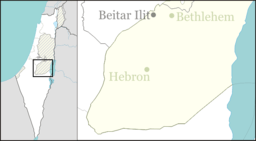Cave of Horror
The Cave of Horror is the name given to Cave 8 in the Judaean Desert, where the remains of Jewish refugees from the Bar Kokhba revolt were found.[1] The cave lies in the southern cliff of Nahal Hever, adjacent to the Cave of Letters located on the northern cliff of the river, where many documents from the Bar Kokhba revolt were uncovered.[2]
| The Cave of Horror | |
|---|---|
 | |
| Location | Ein Gedi, Israel |
| Coordinates | 31°25′48″N 35°20′52″E |
In the Cave of Horror, there were fewer finds since they were explored by Bedouins before Yigael Yadin's excavation of the site in 1960. The nickname "Cave of Horror" was given after the skeletons of 40 men, women and children were discovered.
Later on, a number of fragments of letters and writings were discovered in the cave, among them were a number of Bar Kokhba coins and a Greek copy of the Book of the Twelve.[3][4] Three potsherds with the names of three of the deceased were also found alongside the skeletons in the cave. At the top of the cliff above the cave were the ruins of a Roman camp, similar to the one found above the Cave of Letters. It was used for the Roman siege of the Jews hiding in the Cave of Horror.
Read more
References
- "Judean Desert Caves". Jewish Virtual Library.
- Magness, Jodi (2012). The Archaeology of the Holy Land: From the Destruction of Solomon's Temple to the Muslim Conquest. Cambridge University Press. p. 261.
- Dimant, Devorah (2012). The Dead Sea Scrolls in Scholarly Perspective: A History of Research. Brill. p. 385. ISBN 978-9004208063.
- "Featured Scrolls". Dead Sea Scrolls.